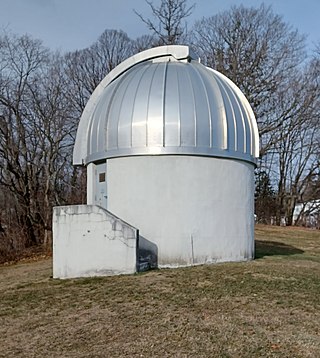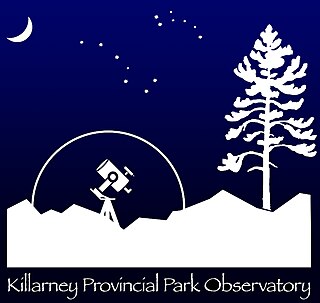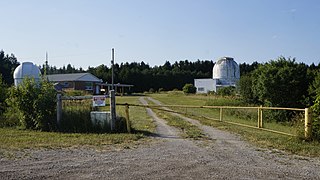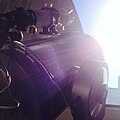
The Mount Wilson Observatory (MWO) is an astronomical observatory in Los Angeles County, California, United States. The MWO is located on Mount Wilson, a 1,740-meter (5,710-foot) peak in the San Gabriel Mountains near Pasadena, northeast of Los Angeles.

The Dominion Astrophysical Observatory, located on Observatory Hill, in Saanich, British Columbia, was completed in 1918 by the Canadian government. The Dominion architect responsible for the building was Edgar Lewis Horwood. The main instrument is the 72-inch-aperture (1.83 m) Plaskett telescope, proposed and designed by John S. Plaskett in 1910 with the support of the International Union for Cooperation in Solar Research.

The David Dunlap Observatory (DDO) is an astronomical observatory site in Richmond Hill, Ontario, Canada. Established in 1935, it was owned and operated by the University of Toronto until 2008. It was then acquired by the city of Richmond Hill, which provides a combination of heritage preservation, unique recreation opportunities and a celebration of the astronomical history of the site. Its primary instrument is a 74-inch (1.88 m) reflector telescope, at one time the second-largest telescope in the world, and still the largest in Canada. Several other telescopes are also located at the site, which formerly also included a small radio telescope. The scientific legacy of the David Dunlap Observatory continues in the Dunlap Institute for Astronomy & Astrophysics, a research institute at the University of Toronto established in 2008.
The Fick Observatory was an astronomical observatory owned and operated by Iowa State University. Located southwest of Boone, Iowa, it was named after Davenport, Iowa, amateur astronomer Erwin W. Fick. The observatory closed in 2015.

Foothill Observatory is an astronomical observatory owned and operated by Peninsula Astronomical Society (PAS) and Foothill College. It is located on the college's campus in Los Altos Hills, California (US). The observatory is used by students enrolled in the introductory astronomy lab on campus, which is part of the college's thriving astronomy for non-scientists program, serving over 800 students per year. A 16-inch (410 mm) Schmidt-Cassegrain telescope was donated to the observatory and went into operation in 2007.

Bowman Observatory is an astronomical observatory owned and operated by the Greenwich, Connecticut Board of Education.
C. E. K. Mees Observatory is an astronomical observatory in Bristol, New York, owned and operated by the University of Rochester. The observatory is named after C. E. Kenneth Mees, "in honor of his pioneering work in the development of sensitive photographic emulsions for use in astronomy."
Brooks Astronomical Observatory is an astronomical observatory owned and operated by Central Michigan University. It is located in Mount Pleasant, Michigan (USA). The observatory was established in 1964 and is located on the roof of the Brooks Hall science building. Both the building and observatory are named for Kendall P. Brooks, instructor of astronomy and other subjects in the period of 1910-1947.
The William G. and Retha Stone Baker Observatory is an astronomical observatory owned and operated by Missouri State University. It is located in Marshfield, Missouri.

The Algonquin Radio Observatory (ARO) is a radio observatory located in Algonquin Provincial Park in Ontario, Canada. It opened in 1959 in order to host a number of the National Research Council of Canada's (NRC) ongoing experiments in a more radio-quiet location than Ottawa.
The University of Toronto Southern Observatory (UTSO) was an astronomical observatory built by the University of Toronto at the Las Campanas Observatory in Chile. It hosted a single 60 cm Cassegrain telescope and a small cottage for the operators, located amongst the instruments funded by other organizations. The first observational runs started in 1971, and like many smaller instruments, it was later shut down in favor of a partial share in a much larger telescope in 1997. Although small by modern standards, the Southern Observatory nevertheless became famous for its role in the discovery of SN 1987A when UofT astronomer Ian Shelton spotted the supernova while observing with another little-used telescope at the site.

The Givatayim Observatory is a public observatory that was founded in 1968 by the Israeli Astronomical Association and the Givatayim municipality.

The Heights Observatory is an Astronomical Observatory at The Heights School in Modbury Heights, Adelaide, South Australia.
The SUNY Oneonta College Observatory is an astronomical observatory in Oneonta, New York. The observatory is home to the largest optical telescope in New York: a 1-meter Newtonian reflector. It is also believed to be the one of the largest telescopes open for public observing east of the Mississippi. The telescope was constructed by JMI Telescopes of Lakewood, Colorado.
The Whakatane Astronomical Society is a voluntary, non-profit society for people interested in amateur astronomy in the Whakatane District of New Zealand. The society was founded in September 1960, and maintains a small observatory in Whakatane, which has been operating continuously since 1964. The society is affiliated with the Royal Astronomical Society of New Zealand.
The Mount Stony Brook Observatory is an astronomical observatory operated by Stony Brook University in Stony Brook, New York. It is located on the roof of the Earth and Space Sciences Building. The dome contains a Meade 14" Maksutov–Cassegrain telescope and SBIG (SBIG-STL1001e) imaging equipment. The telescope is used for teaching undergraduate and graduate astronomy labs by the department, as well as by the Astronomy club. The observatory's imaging capabilities have been used to monitor variable stars. On the first Friday of every month during the school year the department hosts "Astronomy Open Nights" during which a lecture is given, followed by observing if the weather permits. The observatory was built in 1968 and Astronomy Open Nights have been held there since 1976. The current telescope was installed in 1981.

The Killarney Provincial Park Observatory is an astronomical observatory located at the George Lake Campground of Killarney Provincial Park . The Observatory is operated by Ontario Parks and houses two observatory buildings. The original facility contains a 10" telescope with solar filter, ideal for nighttime as well as daytime viewing of the Sun. The newer facility contains a 16" fully automated telescope with a 5" refractor and is ideal for research, astrophotography and public use. The telescopes are available for Discovery programs as well as private sign-out (self-use) by interested visitors.

The Elginfield Observatory is an astronomical observatory located in the township of Middlesex Centre, Ontario, Canada, about 25 kilometres (16 mi) north of London, Ontario. The observatory is owned and operated by the University of Western Ontario, and opened in 1969. The observatory features a 1.2 m (47 in) Ritchey–Chrétien telescope built by Boller and Chivens which is used for spectroscopy and photometry. The telescope can be configured to feed instruments at the Cassegrain, Nasmyth, and Coudé foci. Recent research includes monitoring the changing size of Cepheid variable stars, estimating out-gasing of minor planets, and searching for large Perseid meteoroids.

Bayfordbury Observatory is the University of Hertfordshire's astronomical and atmospheric physics remote sensing observatory, and one of the largest teaching observatories in the UK. It is located in the relatively dark countryside of Bayfordbury, Hertfordshire, 6 miles from the main university campus in Hatfield. The first telescope was built in 1969, and since then has been used as a teaching observatory for undergraduate students, staff and student research as well as for public outreach activities.

The ÇOMÜ Ulupınar Observatory (UPO) is a ground-based astronomical observatory, which was established in 2001 and formally opened on 19 May 2002. It is also known as Çanakkale Observatory or the University Observatory. The Ulupınar Observatory is part of the Çanakkale Onsekiz Mart University (ÇOMÜ) Faculty of Science and Arts.




















